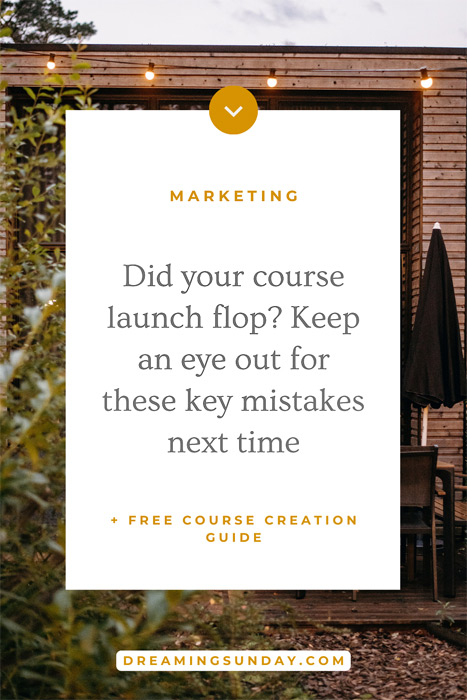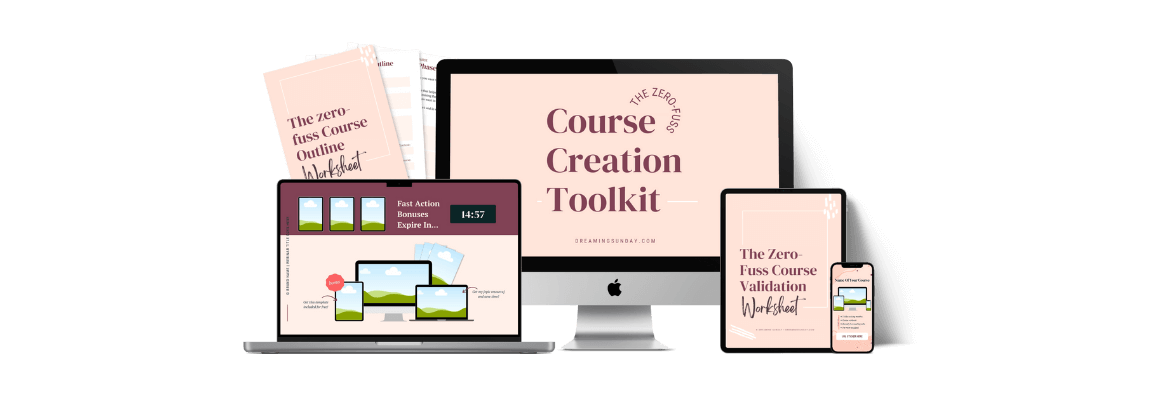Did your course launch flop after you put tons of time, effort and money into creating your online course? Ouch. But don’t give in to the frustration and abandon your course. A launch failing isn’t the end of the world and I’m going to show you how to shift things so your next launch is a success.

Why can your course launch flop and what are you making it mean about yourself?
There are dozens of reasons why a course launch can fail and not give you the results you were hoping for. From the wrong messaging to tech issues, it’s important that you look into what caused yours to flop so you can fix it and get better results next time.
That’s right, next time. Because a launch flopping doesn’t mean your course is sh*t, nor is it a sign you should quit creating courses.
Launching is a muscle you can flex. I bet the first time you rode a bike you fell to the ground, but you didn’t give up on riding a bike. You got back up and tried again and now it’s second nature to you.
Same with creating and launching courses. But we’re so hard on ourselves that when we do it for the first time and it doesn’t work, we just give up altogether. Don’t.
Be careful what you make your course flopping mean about yourself because it can derail your path as an entrepreneur and course creator in big ways.
You’re not your results, whether they’re good or bad. You’re just doing your best with the resources you have, and with time and practice, you’ll get better at it.
That said, here are the main reasons why a course launch can flop and how to fix them.
1. Your course idea hasn’t been validated
This is what causes most first time course creators to have their launch flop. If you created what you thought people wanted without confirming it first, your course likely didn’t hit the mark for your audience.
It’s important that you validate your course idea before creating it. It’s a lot easier to find a product for your audience, than an audience for your product.
What you think people want and what they actually want can be drastically different. Trust me, been there, done that (repeatedly).
To validate your idea, the fastest way to do so is through market research calls with people in your ideal audience. Let them tell you what they’re struggling with and what they need from you. They’ll be lining up to buy your course if it tackles their specific problems.

You can also do review mining in courses in similar niches to see what people liked, what they felt was missing and what disappointed them. You can use this info to make your course better (no copying what others are doing, just find the gaps you can fill!).

Free guide
Go from course idea to launch with this step by step roadmap
2. Your course doesn’t have a strong promise or provide a clear transformation
An important thing to keep in mind is that people don’t take courses for the sake of learning or finding ways to spend their lazy sundays.
They enroll in courses because they have problems or aspirations that they need help with. That’s where your course comes in, bridging the gap between where they are and where they want to be.
A strong promise or a clear transformation make your course compelling and actionable. So people don’t have to spend weeks deciding if it’s the right fit for them or not.
For instance, which course sounds more appealing?
- Course A promises to teach you the basics of oil painting
- Course B promises that you’ll have your first, complete oil painting of a landscape in 7 days
Not sure about you, but I’d rater buy course 2. I’d rather have a complete painting within 7 days of taking the course. The painting may be blah if it’s my first but I have something to show up for it.
With Course A, I might learn how to paint with oils but I might not paint a single thing in months. See the difference?

What does your course promise, solve or what’s the transformation people go through when they take your course?
If you’re not clear and able to convey this to your audience in a line or two, spend some time thinking about it. You may need to reorganize and update your course a bit to make sure it delivers on the promise or transformation you decide on.
3. Your course has too much or too little content
While you’re at it, you may want to check your course content and see if it’s too much, too little, or exactly the right amount of content needed.
We tend to think that a course needs to be BIG and have dozens of hours of materials for it to be “worth it” and command a high-ticket price. But it might just be the reason your course isn’t selling!
Like I said before, people are looking for a solution or a way to fulfill an aspiration or desire. With this in mind, do you think they want to spend weeks going through hours of content? Nope.

That’s why every marketer asks you “If I could wave a magic wand and have a problem solved for you, what would it be?”. Sure, they’re asking to find the “problem” but people want a “magic wand” solution.
Magic wands don’t exist yet so the next best thing is a course so lean and powerful, that they can get the promised results without having to put in tons of effort. Don’t get me wrong, people are willing to work hard for what they want, but not unnecessarily.
Look at your course outline. Are there ANY lessons or any sections within lessons, that aren’t strictly necessary to achieve the outcome they want? If there are, take them out of the program.
You can turn those into bonuses or extra materials, but keep the curriculum of your course lean so people can take action without getting bogged down in unnecessary steps or watching dozens of videos.
If your course has too much content, people won’t buy, or they’ll buy and then refund, because they will get overwhelmed. Avoid overwhelm by having a tight curriculum.
Similarly, if your course doesn’t include enough information for people to achieve the desired outcome, they won’t buy. You want to hit the sweet spot where it has just the right amount of information needed, complemented with bonuses so it doesn’t feel overwhelming for your students.
Need help creating & launching tour course? Get instant access to the Course Creation Toolkit.

Quickly create your online course with customizable, done-for-you resources.
4. You messaging isn’t resonating with your audience
You may have the best course, the best promise, the best launch plans… But if your messaging is off during your launch, it won’t do well.
How are you talking about your course? Are you clearly addressing your audience’s struggles, pain points, objections, desires and aspirations?
Are you painting a vivid picture of their before and after if they go through your course?
Do they see themselves in your copy when you describe who the course is for, how it helps and what’s in it for them? Could they say “dang you read my mind” when reading your emails?
Honing your messaging is key, but it’s also not something you should expect to get right on your first launch.
The more you talk to your people and hear what they say, the more you’ll understand them and the better you’ll be able to speak to them through your marketing materials.
If you didn’t get your messaging right on your first launch, keep listening and improving your copy!
5. You don’t have an engaged audience or they don’t fully trust you yet
Another common reason why courses can flop when you launch them is because you don’t have an audience. I go over why you don’t need a big email list to launch your course here, but you do need an audience to launch a course.
Sometimes a launch can be all about the numbers and this is especially true when you’re just starting out and don’t have a big community yet.
Normally you can expect 1-2% of your email list enroll in your course. But what if you only have 100 subscribers? That could be 1 person enrolling in your course, if you’re lucky. Or maybe nobody buys because they don’t trust you yet.
In that case, you can still launch and get some practice in! But don’t set unreachable expectations that’ll just dissuade you from launching ever again.
Continue growing and nurturing your email list and community as a whole and launch again. You’ll see much better results when you have a growing and more engaged community!
Similarly, you may have 10,000 subscribers on your list but the last time they heard from you was 7 months ago…? Chances are they won’t trust you enough to enroll in your course and know you won’t just disappear on them again.
Make sure you continue nurturing your subscribers and your community regularly. If you only show up to sell to them, they won’t stick around — let alone buy from you.
![[FREE] Lead Magnet Previews Mock-ups (vertical) - Dreaming Sunday](https://dreamingsunday.com/wp-content/uploads/2023/12/FREE-Lead-Magnet-Previews-Mock-ups-vertical-Dreaming-Sunday.png)
Free templates
Supercharge your landing pages + opt-in forms with these lead magnet mock-up templates
6. You’re not overcoming their objections
Like I said in this other article, even when you’re offering people exactly what they desire, their first instinct is to say no. They’ll try to fight for their limitations and convince themselves that they’re fine and don’t need whatever you’re selling.
This is where addressing their objections becomes essential. An objection is the reason they’re telling themselves why they can’t or shouldn’t invest in your course.
The most common objections people have are:
- They don’t have the time to dedicate to the course or achieving the goal
- Thinking they can’t afford the course or that they shouldn’t spend money on it
- Not believing it can work for them because they already tried in the past and failed
- Fear of what people will say if they try and fail, or if they succeed
- Not believing they’re worth investing in themselves

Your sales page, sales email sequence, social media posts, webinars, etc. need to address your audience’s biggest objections so you can help them overcome them.
If your audience gets to release these objections before the cart closes, they’ll be much more likely to enroll in your course.
Can you share case studies, testimonials or other inspiring stories to show them they’ve got what it takes? Show them that others in a similar situation made it work for them? Help them feel confident in taking the leap and trust in themselves?
7. You launched during a high competition period
What’s the best month to launch a course? Normally I say anytime’s good. But if you’ve never launched a course before, you should avoid high competition months or periods.
Launching can be really stressful and take up a lot of your time. But if you also launch on the busiest time of year where every business is fighting for people’s attention, you’ll have a challenging time.
Highly recommend avoiding launching for the first or second time during the following times:
- Valentine’s day / Superbowl
- Easter / Spring Break
- 4th of July weekend
- Black Friday (or November altogether since Black Friday went from being a single day to being a whole month now…)
- Christmas (mid-December on, people are out celebrating, spending on gifts…)
There’s going to be too much competition, people will be distracted or offline, and they’ll put their money elsewhere. You don’t want to go through all the work of a launch only for people not to pay attention or enroll because others are yelling harder.

When is your audience online the most outside of these busy periods? When have you noticed people are paying attention to you so you can leverage it for a launch?
8. You didn’t promote your course much out of fear
Saving the best for last. As a new course creator, it’s easy to feel like your course isn’t good enough, fall prey to the belief that people won’t buy it, or find it useful and request a refund…
If your launch isn’t off to an epic start, you’ll convince yourself that your launch is a flop and your course is the worst, and in return you stop showing up in your launch.
You stop promoting it, skipping sending some of the emails you had planned and you think about pulling the plug altogether.

But that’s exactly what you shouldn’t do. When you feel like pulling the plug, let it be your sign to show up with more confidence and believe in your course even harder.
Make a list of 20 reasons why your course is amazing and it will help people immensely. The more you believe in your course, the easier it’s to show up and sell it. People will feel your energy. If they feel you’re unsure about your course, they won’t buy it.
You need to show them how powerful it is and how much it’ll change their lives. They’ll be lining up to enroll after that.
Having a coaching session with a mindset coach during your launch can help you feel more confident in yourself and your course so you can give it your all. Send me an email if you’d like to work with me.
Don’t hold back, your course will solve someone’s problem or help them achieve a goal they never thought was possible for them. Don’t keep them waiting because of fear.

Free guide
Go from course idea to launch with this step by step roadmap
Over to you – Feel ready to turn a course launch flop into a successful one on your next try?
Now that you know the most common reasons why your course launch can flop, do you feel like you can make your next launch a hit?
Launches aren’t always predictable, but when you know the most common pitfalls, you can make a plan of action to avoid them!
Once you’ve launched your course a few times, it’ll feel like second nature to do it and you’ll be able to add more complexity to it. For instance, adding more webinar sessions, spending thousands in ads to grow your list, or even launching during Black Friday.
Leave a comment below and let me know what it was like if you’ve had a launch that didn’t do well? And what you plan to do to make your next one a success?
